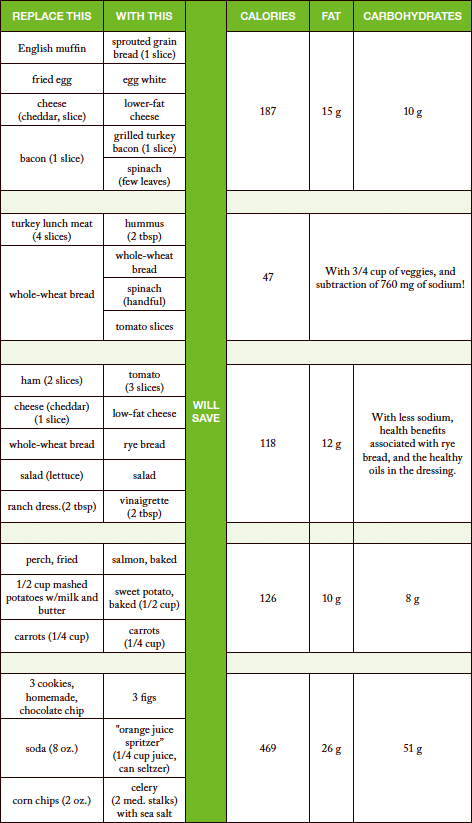 |
 |
Healthy Up Your DietBy Sara Tiner These days, we all get plenty of advice on how to avoid the worst food choices, from "Don't buy the 'meal' at a fast-food restaurant" to "If you need to run into the convenience store, take only enough cash for the purchase" to "Stay on the perimeter of the grocery store; that's where the healthier foods [e.g., fruits and vegetables] are." But what if garbage bags or cat food are on your grocery list? Should we hire a shopping mercenary for a quick, temptation-free retrieval of these necessities from the "bad" middle section of the store? Maybe we should teach our cats to eat lettuce. (Good luck with that.) Really, the only way to tame the processed food monster is to outsmart it. Unfortunately, the deck is stacked. Food advertising promotes the unhealthiest items - overloaded with fat and piled high at two to three times what an adult portion should be. Food is available everywhere we go - in vending machines at schools and gyms, food courts at department stores and malls, restaurants that take your phone/fax/online order so you can pick up a meal on your way home, drive-thru coffee, fast food ... the list is seemingly endless. Add these facts of life to the reality that many of us are increasingly sedentary at both our jobs and in our leisure activity, and Houston, we have a problem. Too Much Weight = Trouble
Conditions Associated With Overweight/Obesity Nutrition is complex and highly individualized. Each person has different caloric needs, activity levels and food likes/dislikes. The key is to spend some time thinking about what we eat and how we eat. Then we can make strategic changes that will allow us to fuel up without ballooning up. Get the Most From Your Food Food is fuel, but it's so much more. Eating is often the most reliable social part of our day with family or friends. It represents a chance to care for others or ourselves. What we ate as children can comfort us or bring back wonderful memories. And trying new foods can heighten our senses and provide the thrill of novelty. But at its foundation, food needs to be what it is - fuel. If our way of feeding others or ourselves puts us on a path toward obesity or its related diseases, then we're misusing food. As a habitual tool for comfort or as a reward, food can becomes an instrument for the psyche and takes on a role it isn't strictly meant to play. A Strategic Plan to Healthy Up Your Diet Eating healthy is a process. We look at where we are, see where we want to be and figure out how to get there. To look at where we are, we need to examine our habits and food choices. As an example, let's say we've fallen into the habit of grabbing a mocha coffee drink (with whip, of course) on the way to work, and heck, why not a scone? So, before we even check our e-mail, we've consumed (assuming a 2,000 calorie-a-day diet), 39.5% of our daily calories, 55% of our total fat, 22% of our sodium, 34% of our carbs (assuming we're getting about 60% of calories from carbs), and 20 grams of protein.
With the exception of the protein, those are pretty sobering figures. More sobering, what you've consumed will still leave you craving a mid-morning snack, and probably sooner than later. How about substituting a coffee/hot chocolate mix and toast? Well, that's better: 18% of our daily calories, 19% of total fat, 9% of sodium and 8% of our calories from carbs, with 11 grams of protein. And we're getting good fats from the peanut butter and fiber from the bread
Easy Versus Healthy
That said, healthy eating requires some planning. Here are a few meals and some key ingredient substitutions that can help keep unnecessary calories out of your mouth (and body): Making Healthier Choices: Some Key Things to Consider
Making healthier choices isn't easy, certainly not these days and certainly not when it comes to food, but the choices you do make can make a big difference. No one's telling you swear off your favorite foods (if they happen to be less-than-optimal in terms of nutrition); it's about shifting the balance of what you eat so you end up with more healthy foods and less unhealthy ones. Now that's a recipe for long-term health and wellness. REPLACING THIS WITH THAT: How to Improve the Health Profile of Common Meals

Here are just a few of the health problems associated with obesity:
Sara Tiner, BA, BS, MS, is the coordinator of scientific communication for a whole-food supplement manufacturer in Wisconsin. With undergraduate degrees in biology and English from Ripon College, and a master's degree in journalism from Columbia University, she's worked as a science writer in both print and radio over the past decade, and moonlights as a freelance contributor to various publications. |